Oilfield part machining has long been the backbone of energy production, ensuring that drilling rigs, pipelines, pumps, and other vital equipment operate efficiently under the most demanding conditions. With the energy sector undergoing a significant transformation driven by technological advancements, sustainability requirements, and global demand shifts, oilfield part machining is also evolving at a rapid pace. To remain competitive and reliable, machining service providers are adopting cutting-edge solutions that enhance precision, efficiency, and environmental responsibility.
This article explores the future trends shaping oilfield part machining and highlights the innovations that will define its role in the energy sector over the coming decades. From automation to sustainability, the integration of digital technologies and new materials, the future of machining promises to strengthen the reliability of energy infrastructure worldwide.
Automation and Robotics in Oilfield Part Machining
Automation is transforming industries across the globe, and oilfield part machining is no exception. The growing use of robotics and computer-controlled systems is helping manufacturers streamline production processes, reduce human error, and achieve a higher degree of accuracy in machining complex components. In oilfield applications where safety and reliability are paramount, robotic systems can operate continuously with minimal downtime, making production both faster and more cost-effective.
Robotic machining systems also improve consistency, especially in repetitive operations like drilling, turning, or milling parts with tight tolerances. By reducing reliance on manual labor, automation lowers the risk of workplace injuries in hazardous environments and ensures a consistent quality of output. As energy companies continue to expand their operations in challenging environments like offshore drilling, the demand for precision parts manufactured with automation will grow exponentially, setting a new industry standard.
Advanced Materials and Additive Manufacturing
One of the most significant trends in oilfield part machining is the use of advanced materials that can withstand extreme pressure, heat, and corrosive conditions. High-performance alloys, composites, and ceramics are increasingly being used in drilling tools, valves, and pumps. Machining these materials requires specialized techniques and equipment capable of handling their hardness and durability without compromising accuracy. This trend is pushing the boundaries of traditional machining and fostering innovations in cutting tools and machine design.
Additive manufacturing, also known as 3D printing, is another emerging technology that is influencing oilfield part machining. By enabling the production of complex geometries and customized components, additive manufacturing reduces material waste and shortens lead times. In the future, hybrid manufacturing—combining traditional machining with additive techniques—will likely become a standard practice in the oilfield sector, offering greater flexibility and efficiency in producing both standard and highly specialized parts.
Digital Transformation and Smart Machining
Digitalization is reshaping oilfield part machining through the integration of smart technologies such as the Internet of Things (IoT), artificial intelligence (AI), and digital twins. These tools enable real-time monitoring of machining processes, predictive maintenance of equipment, and optimization of production lines. For instance, AI algorithms can analyze machine performance data to predict potential failures, allowing for proactive interventions that minimize downtime.
Digital twins—virtual replicas of physical components—are particularly valuable in oilfield part machining. They allow manufacturers to simulate machining processes, test part designs, and optimize production before actual manufacturing begins. This reduces trial-and-error costs and ensures parts meet the high performance standards required in oilfield operations. As the energy sector continues to embrace digital transformation, smart machining will become a cornerstone of efficiency, precision, and cost-effectiveness.
Sustainability and Green Machining Practices
Sustainability is becoming a key driver of change in the energy industry, and oilfield part machining is no exception. Traditional machining processes often generate significant material waste and consume large amounts of energy. To address these challenges, manufacturers are adopting green machining practices, such as using biodegradable lubricants, optimizing cutting strategies to reduce waste, and investing in energy-efficient machinery. These eco-friendly approaches not only minimize the environmental impact but also reduce operational costs in the long run.
Recycling and reusing machined parts is another important aspect of sustainable oilfield part machining. With rising pressure from regulatory bodies and increasing corporate commitments to sustainability, manufacturers are exploring ways to refurbish worn-out components instead of producing new ones. This circular approach not only conserves raw materials but also extends the lifecycle of critical oilfield equipment, making it an essential part of the industry’s future.
Globalization and the Future Workforce
The globalization of energy markets is also shaping the future of oilfield part machining. With oil and gas operations expanding across continents, there is a growing need for standardized machining practices that ensure compatibility and reliability of parts worldwide. International collaboration and supply chain integration are driving the adoption of uniform machining standards and certifications, which help reduce risks and ensure consistent quality across global projects.
At the same time, the oilfield part machining industry faces a workforce challenge. As older generations of skilled machinists retire, there is a pressing need to attract and train a new generation of professionals proficient in advanced machining technologies. This includes expertise in automation, digital systems, and sustainable practices. Investment in training and education will be critical to ensuring the industry’s ability to meet the evolving demands of the energy sector and maintain a skilled workforce capable of adapting to future challenges.
Conclusion
The future of oilfield part machining in the energy sector is one of innovation, efficiency, and sustainability. From the adoption of robotics and advanced materials to the integration of digital technologies and eco-friendly practices, the industry is rapidly evolving to meet the needs of a changing world. Globalization and workforce development will further influence how manufacturers adapt to rising demand and new challenges.
As the energy sector continues its transformation, oilfield part machining will play a pivotal role in ensuring reliability, safety, and cost-effectiveness. Companies that embrace these future trends will not only secure a competitive advantage but also contribute to a more sustainable and technologically advanced energy industry.



